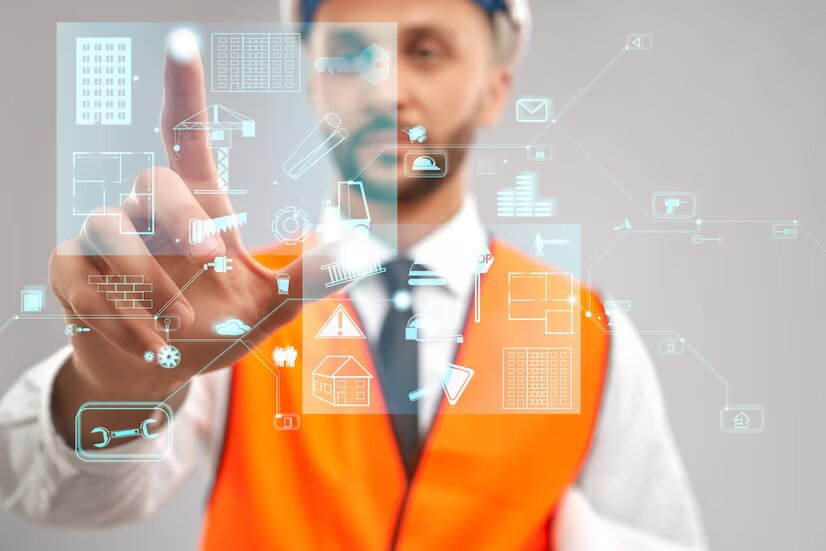
The construction industry is a vital component of our global economy, providing essential infrastructure and housing for communities around the world. However, the industry faces several significant challenges, including labor shortages, rising material costs, and increasingly complex design requirements. Fortunately, technology is revolutionizing the construction industry, providing new tools and techniques that address these challenges and streamline the building process.
From Building Information Modeling (BIM) to drones and robotics, virtual and augmented reality, 3D printing, and the Internet of Things (IoT), technology is transforming every aspect of the construction industry. These innovations are making it easier and more efficient to design, build, and maintain structures, saving time and money and improving safety and quality.
In this blog, we will explore how technology is revolutionizing the construction industry and the various ways it is transforming the construction process. We will discuss the benefits of these technological advancements and the future potential they hold for the construction industry. Whether you are a construction professional or simply interested in the latest technology trends, this blog will provide you with valuable insights into how technology is changing the face of construction.
Building Information Modeling (BIM)
The term “Building Information Modeling” (BIM) refers to a computerized model of a structure’s structural and operational details. An exact and detailed three-dimensional model of a building’s geometry, materials, construction sequence, and operational specifics are all made possible by this technology. By using BIM, builders can improve communication, streamline the construction process, and make more educated decisions.
One of the significant advantages of BIM is its ability to reduce errors and increase efficiency. With BIM, project stakeholders can identify and resolve design issues early in the process, before construction begins. BIM also enables project teams to visualize the entire building, including its systems and subsystems, allowing them to optimize layouts, reduce waste, and improve functionality.
BIM is used in construction projects of all sizes and types, from small renovations to large-scale infrastructure projects. For example, BIM is used in the construction of hospitals and other healthcare facilities to ensure that patient rooms are designed to maximize efficiency and safety. In infrastructure projects, BIM is used to model bridges, tunnels, and highways to ensure that they are constructed to meet exacting standards and to optimize traffic flow.
In the future, BIM will play an even more critical role in the construction industry. With the advent of artificial intelligence and machine learning, BIM will become even more sophisticated, providing real-time data on building performance and predicting maintenance and repair needs. BIM will also become more accessible, with cloud-based solutions that enable project teams to collaborate seamlessly across multiple locations and time zones.
Drones And Robotics
Drones and robotics are increasingly being used in the construction industry to improve safety, efficiency, and productivity. Drones, or unmanned aerial vehicles (UAVs), are used for aerial surveys of construction sites to monitor progress, while robots are used for tasks such as bricklaying and excavation.
Drones are equipped with cameras, sensors, and other technology that enables them to collect data on construction sites from above. This data can be used to create highly detailed and accurate maps, which can help construction teams plan and execute projects more efficiently. For example, drones can be used to survey sites before construction begins, monitor construction progress, and inspect structures after completion. This technology helps to reduce the time and cost associated with traditional surveying methods and improves safety by reducing the need for workers to access dangerous areas.
Robotics are also transforming the construction industry by automating repetitive and physically demanding tasks. For example, bricklaying robots can lay bricks faster and with more precision than human workers, reducing labor costs and improving quality. Similarly, excavation robots can perform tasks such as digging foundations and trenches, reducing the need for manual labor and improving safety.
The future potential of drones and robotics in construction is vast. With advancements in technology, these machines will become even more efficient and capable of performing increasingly complex tasks. For example, drones equipped with artificial intelligence (AI) will be able to analyze data in real time, allowing for even more accurate and timely decision-making. In addition, robotics will continue to evolve, with the potential to automate a wider range of tasks, including painting and welding.
Virtual And Augmented Reality
Virtual and augmented reality (VR/AR) are technologies that are transforming the construction industry by allowing project stakeholders to experience building designs in three dimensions. VR/AR technology creates a simulated environment that can be explored and interacted with, providing a realistic preview of how a structure will look and feel once it is built.
The use of VR/AR technology has numerous advantages in construction. It allows designers, architects, and builders to visualize and make changes to a building’s design before it is built, reducing the risk of errors and changes during the construction process. Additionally, it enables project teams to collaborate more effectively, by allowing them to visualize the entire building in real-time and share ideas more easily. This technology can also be used to train workers and simulate construction scenarios, improving safety and reducing accidents.
There are several examples of how VR/AR technology has already improved safety and efficiency in construction. For example, some construction companies are using AR headsets to provide workers with real-time instructions and warnings on job sites, reducing the risk of accidents and errors. Others are using VR to train workers on how to operate heavy machinery and handle dangerous materials safely.
In the future, the potential of VR/AR technology in construction is enormous. As the technology becomes more accessible and affordable, it will enable more construction companies to incorporate it into their processes. For example, designers will be able to create virtual models that can be explored in real-time by project stakeholders from around the world, making collaboration easier and more effective. Similarly, builders will be able to use AR to superimpose virtual models onto real-world construction sites, allowing for more accurate and efficient construction.
3d Printing
3D printing technology is revolutionizing the construction industry by allowing builders to print entire structures using a range of materials, including concrete, plastic, and even metal. This technology has the potential to significantly reduce the cost and time associated with traditional construction methods while improving quality and sustainability.
One of the primary advantages of 3D printing in construction is its ability to reduce waste and increase sustainability. Traditional construction methods typically involve a significant amount of waste material, but with 3D printing, only the required amount of material is used. In addition, 3D printing enables the use of recycled materials, which can further reduce the environmental impact of construction.
Another advantage of 3D printing is its ability to reduce construction time and costs. 3D printers can produce parts and components in a fraction of the time it takes to produce them using traditional methods, reducing labor costs and increasing efficiency. Additionally, 3D printing can be used to produce complex shapes and structures that are difficult or impossible to create using traditional methods, improving the quality and durability of the final product.
There are already numerous examples of how 3D printing technology is being used in construction. For example, in China, a company called WinSun has used 3D printing to build entire houses, apartments, and even an entire five-story apartment building. In the Netherlands, MX3D used 3D printing to construct a pedestrian bridge made entirely out of metal, while in the United States, a company called Mighty Buildings is using 3D printing to create affordable, sustainable housing.
In the future, the potential of 3D printing in construction is vast. As the technology continues to evolve, it will enable builders to create more complex and intricate structures, using a wider range of materials. This technology has the potential to significantly reduce the environmental impact of construction while improving quality, efficiency, and affordability.
Internet Of Things (IoT)
The Internet of Things (IoT) is a rapidly growing technology that is transforming the construction industry by enabling the connectivity of devices and equipment. IoT allows for the integration of sensors, software, and other smart technologies to collect and analyze data, improving health and safety, efficiency, and productivity in construction.
One of the primary advantages of IoT in construction is improved safety. IoT devices can monitor job sites in real time, detecting potential hazards and providing alerts to workers and supervisors. For example, sensors can detect gas leaks, fire risks, or even dangerous weather conditions and provide real-time alerts to workers and managers. IoT can also be used to monitor worker activity and provide training to improve safety practices.
Another advantage of IoT is increased efficiency. IoT sensors can monitor the use of equipment and materials, providing data to project managers to optimize operations. For example, sensors can monitor the use of machinery and provide insights into maintenance requirements and scheduling. This can help reduce downtime and minimize costs associated with maintenance and repairs.
IoT is already being used in several construction projects around the world. For example, sensors are being used to monitor the construction of the new Salesforce Tower in San Francisco. These sensors are tracking the movement of materials, equipment, and workers to optimize the construction process and improve safety. Another example is the use of IoT sensors in the construction of the new Istanbul Airport. These sensors are monitoring everything from temperature and humidity levels to worker movements, enabling project managers to optimize the construction process and improve productivity.
In the future, the potential of IoT in construction is vast. As the technology continues to evolve, it will enable builders to connect and monitor an ever-increasing range of devices, creating a seamless and connected construction process. This technology has the potential to significantly reduce costs, improve efficiency, and enhance safety in construction projects of all sizes and types.
Conclusion
In conclusion, technology is revolutionizing the construction industry in unprecedented ways. The adoption of Building Information Modeling (BIM), drones and robotics, virtual and augmented reality, 3D printing, and the Internet of Things (IoT) is transforming the way buildings and infrastructure projects are designed, constructed, and managed.
These technological advancements offer numerous benefits to the construction industry, including improved safety, increased efficiency, reduced costs, and enhanced sustainability. By leveraging these technologies, builders can design and construct buildings and infrastructure that are smarter, safer, and more sustainable than ever before.
The potential of these technologies in the construction industry is vast and will continue to evolve rapidly. As we move into the future, we can expect to see more advanced and integrated technologies that will further transform the construction industry.
Ultimately, the adoption of technology in construction is essential for builders to remain competitive in an ever-changing and increasingly complex industry. Those who embrace these advancements will be able to deliver projects faster, more efficiently, and with improved quality and safety. The future of construction is exciting, and it’s clear that technology will play a crucial role in shaping it.
Additional Reading:






